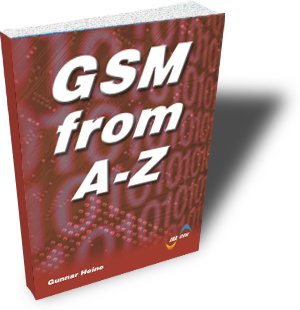Bookstore
GSM from A-Z
Some of your questions that will be answered by this book:

- How can different operators have their networks in the same geographic area and how do they prevent their subscribers from registering in a different network?
- What is the GSM network architecture? What is the function and specifics of the various network elements including the SIM and the mobile station? What is a hierarchical network architecture? What are umbrella cells?
- What is a location area? What is the meaning and differences of the various GSM identifiers like IMSI, IMEI, LAC, BSIC, CGI and so on?
- How is the GSM radio interface organized? What are TDMA and FDMA?
- Why does GSM require different burst types? What is their function? On which channels are they used? What is the meaning of the stealing flags?
- What is the difference between logical and physical channels in GSM? What is the function of the different channel types?
- What is the goal of channel coding and interleaving and how does it work in GSM for the different channel types?
- How do Authentication and Ciphering work in GSM?
- What are the functions and differences of DTX and DRX in GSM?
- What is the content of measurement reports?
- How does call establishment work in GSM? How is a certain channel type selected in case of speech or data transmission?
Who should acquire this book?
- Design Engineers of GSM network equipment and GSM mobile stations.
- Network Planners who need to build joined GSM networks.
- Field and test engineers who have to learn GSM operation and procedures.
- Consultants who require a thorough understanding of GSM
Product Details:
- Paperback
- 152 Pages
- over 55 Illustrations and Tables
- ISBN 978-3-936273-35-9
Price Paperback: Euro 299.- (net)
Price eBook: Euro 249.- (net)
Download the order form and fax or e-mail it to us (inacon@inacon.de)

ℹ️ Try out the updated search below!
Search:
More Info:
General Infomation to this Book
Detailed ToC of this Book
Download an Extract of this Book
INACON eBooks
Please have a look at our full offer

